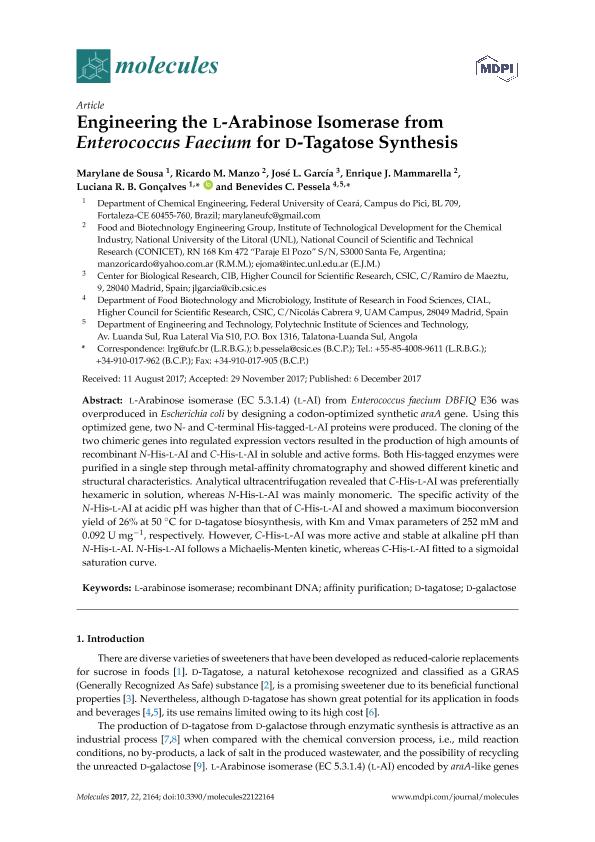Mostrar el registro sencillo del ítem
dc.contributor.author
de Souza, Marylane
dc.contributor.author
Manzo, Ricardo Martín

dc.contributor.author
Garcia, Jose Luis

dc.contributor.author
Mammarella, Enrique José

dc.contributor.author
Gonçalves, Luciana
dc.contributor.author
Pessela, Benevides
dc.date.available
2018-01-17T13:49:58Z
dc.date.issued
2017-12
dc.identifier.citation
Garcia, Jose Luis; Mammarella, Enrique José; Gonçalves, Luciana; Manzo, Ricardo Martín; de Souza, Marylane; Pessela, Benevides; et al.; Engineering the L-Arabinose Isomerase from Enterococcus Faecium for D-Tagatose Synthesis; Molecular Diversity Preservation International; Molecules; 22; 12; 12-2017; 2164
dc.identifier.issn
1420-3049
dc.identifier.uri
http://hdl.handle.net/11336/33578
dc.description.abstract
l-Arabinose isomerase (EC 5.3.1.4) (l-AI) from Enterococcus faecium DBFIQ E36 was overproduced in Escherichia coli by designing a codon-optimized synthetic araA gene. Using this optimized gene, two N- and C-terminal His-tagged-l-AI proteins were produced. The cloning of the two chimeric genes into regulated expression vectors resulted in the production of high amounts of recombinant N-His-l-AI and C-His-l-AI in soluble and active forms. Both His-tagged enzymes were purified in a single step through metal-affinity chromatography and showed different kinetic and structural characteristics. Analytical ultracentrifugation revealed that C-His-l-AI was preferentially hexameric in solution, whereas N-His-l-AI was mainly monomeric. The specific activity of the N-His-l-AI at acidic pH was higher than that of C-His-l-AI and showed a maximum bioconversion yield of 26% at 50 °C for d-tagatose biosynthesis, with Km and Vmax parameters of 252 mM and 0.092 U mg−1, respectively. However, C-His-l-AI was more active and stable at alkaline pH than N-His-l-AI. N-His-l-AI follows a Michaelis-Menten kinetic, whereas C-His-l-AI fitted to a sigmoidal saturation curve.
dc.format
application/pdf
dc.language.iso
eng
dc.publisher
Molecular Diversity Preservation International

dc.rights
info:eu-repo/semantics/openAccess
dc.rights.uri
https://creativecommons.org/licenses/by-nc-sa/2.5/ar/
dc.subject
L-Arabinose Isomerase
dc.subject
Recombinant Dna
dc.subject
Affinity Purification
dc.subject
D-Tagatose
dc.subject.classification
Biotecnología Industrial

dc.subject.classification
Biotecnología Industrial

dc.subject.classification
INGENIERÍAS Y TECNOLOGÍAS

dc.title
Engineering the L-Arabinose Isomerase from Enterococcus Faecium for D-Tagatose Synthesis
dc.type
info:eu-repo/semantics/article
dc.type
info:ar-repo/semantics/artículo
dc.type
info:eu-repo/semantics/publishedVersion
dc.date.updated
2018-01-12T19:44:32Z
dc.journal.volume
22
dc.journal.number
12
dc.journal.pagination
2164
dc.journal.pais
Suiza

dc.journal.ciudad
Basel
dc.description.fil
Fil: de Souza, Marylane. Universidade Federal de Ceará;
dc.description.fil
Fil: Manzo, Ricardo Martín. Consejo Nacional de Investigaciones Científicas y Técnicas. Centro Científico Tecnológico Conicet - Santa Fe. Instituto de Desarrollo Tecnológico para la Industria Química. Universidad Nacional del Litoral. Instituto de Desarrollo Tecnológico para la Industria Química; Argentina
dc.description.fil
Fil: Garcia, Jose Luis. Higher Council for Scientific Research; España
dc.description.fil
Fil: Mammarella, Enrique José. Consejo Nacional de Investigaciones Científicas y Técnicas. Centro Científico Tecnológico Conicet - Santa Fe. Instituto de Desarrollo Tecnológico para la Industria Química. Universidad Nacional del Litoral. Instituto de Desarrollo Tecnológico para la Industria Química; Argentina
dc.description.fil
Fil: Gonçalves, Luciana. Universidade Federal de Ceará;
dc.description.fil
Fil: Pessela, Benevides. Higher Council for Scientific Research; España
dc.journal.title
Molecules

dc.relation.alternativeid
info:eu-repo/semantics/altIdentifier/url/http://www.mdpi.com/1420-3049/22/12/2164
dc.relation.alternativeid
info:eu-repo/semantics/altIdentifier/doi/http://dx.doi.org/10.3390/molecules22122164
Archivos asociados
